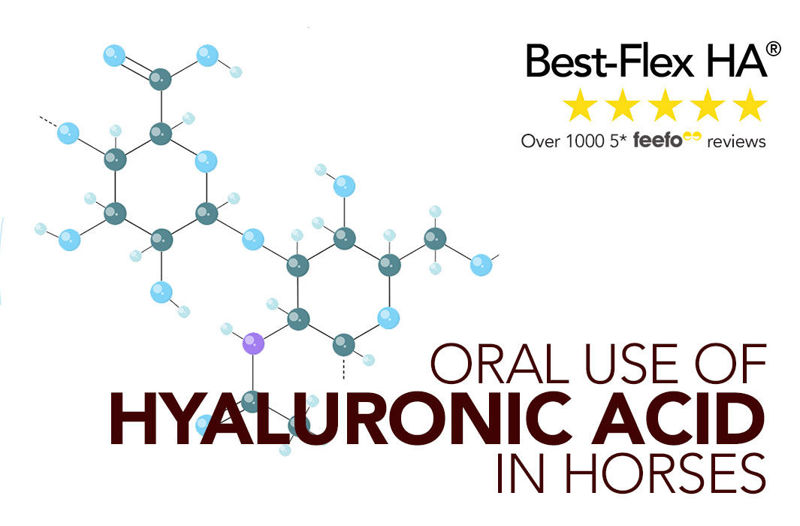Like chondroitin, hyaluronic acid is a glycosaminoglycan (GAG) that is produced by the synovial membrane that lines the joint. It is responsible for the viscosity and lubricating properties of synovial fluid (Weiss, 1977; Nizolek and White, 1981; Tyrnenopoulou, et al. 2018). It has high shock absorbing properties and although horses can make hyaluronic acid, it breaks down relatively quickly during work and is produced less as horses age. Hyaluronic acid also inhibits inflammatory mediators and enzymes involved in articular cartilage degradation, so when supplemented daily can help support joint health and flexibility.
Hyaluronic Acid use in humans
In human studies injectable hyaluronic acid is well known to exert a positive effect in the treatment of arthritis, similar to that of corticosteroids (Colen, et al. 2012). Although injectable hyaluronic acid is more thoroughly studied, oral hyaluronic acid has been shown to reduce pain in patients with knee osteoarthritis (Tashiro et al, 2012; Ricci et al. 2017). In the case of injury an in vitro study Peal et al. (2020) found that synovial fluid around the joint loses hyaluronic acid after injury. A loss of hyaluronic acid increases friction which in turn leads to increased cartilage wear and joint degeneration. The authors concluded that maintaining optimal hyaluronic acid levels within joints, especially after injury, is vitally important.
Oral Hyaluronic Acid use in horses
In horses, like in humans, most of the research carried out has investigated the effects of injectable hyaluronic acid, however there are some studies looking at the effects on oral hyaluronic acid. The first of these was carried out in 2006, specifically due to the lack of research in this area. Bergin et al. (2006) chose forty-eight yearlings with diagnosed with unilateral or bilateral osteochondritis dessicans (OCD) of the tarsus for the study. All horses underwent arthroscopic surgery to remove the OCD lesions. After surgery twenty-four of the yearlings were treated with 100mg/day of oral hyaluronic acid for 30 days and the other twenty-four were given a placebo for 30 days. After 30 days an examiner (who did not know which horses had received the hyaluronic acid and which had the placebo) scored the joints for swelling, on a scale of 0 – 5, with 0 being no swelling and 5 being tennis ball sized swelling. The horses treated with hyaluronic acid had an average swelling score of 0.67, whereas the horses that received the placebo had an average swelling score of 2.05. The authors concluded that the study provided objective evidence for the positive effects on joint swelling of oral supplementation of hyaluronic acid post-surgery.
A later study investigated young horses with osteochondrosis and found that the administration of 250mg/day of oral hyaluronic acid for 60 days resulted in reduced swelling due to synovial fluid build up, as well as lower levels of inflammatory markers in the synovial fluid itself (Carmona et al. 2009) In addition the administration of hyaluronic acid was well accepted by the horses and no adverse clinical affects were seen. The authors concluded that the supplementation of oral hyaluronic acid is safe for use in horses and may help with inflammation associated with osteochondrosis.
Hyaluronic Acid in Best-Flex HA®
As hyaluronic acid is a key component of synovial fluid and has been shown to have a positive effect on joint swelling in horses with joint injury and disease, it is included in Best-Flex HA® and will provide your horse 1100 mg per day. This is the highest quantity of Hyaluronic acid in a joint supplement on the UK market. Buy Best-Flex HA >>
References
- Bergin, B.J., Pierce, S.W., Bramlage, L.R. and Stromberg, A. (2006) ‘Oral hyaluronan gel reduces post operative tarsocrural effusion in the yearling Thoroughbred’ Equine Veterinary Journal, 38(4), pages 375-378.
- Carmona, J.U., Argüelles, D., Deulofeu, R., Martínez-Puig, D. and Prades, M. (2009) ‘Effect of the administration of an oral hyaluronan formulation on clinical and biochemical parameters in young horses with osteochondrosis’, Veterinary and Comparative Orthopaedics and Traumatology, 22(06), pages 455-459.
- Colen, S., Haverkamp, D., Mulier, M. and Van Den Bekerom, M.P. (2012) ‘Hyaluronic acid for the treatment of osteoarthritis in all joints except the knee: what is the current evidence?’ BioDrugs, 26, pages 101-112.
- Nizolek, D.J. and White, K.K. (1981) ‘Corticosteroid and hyaluronic acid treatments in equine degenerative joint disease. A review’ The Cornell Veterinarian, 71(4), pages 355-375.
- Peal, B.T., Gagliardi, R., Su, J., Fortier, L.A., Delco, M.L., Nixon, A.J. and Reesink, H.L. (2020) ‘Synovial fluid lubricin and hyaluronan are altered in equine osteochondral fragmentation, cartilage impact injury and full-thickness cartilage defect models’, Journal of Orthopedic Research, 38(8), pages 1826-1835
- Ricci, M., Micheloni, G.M., Berti, M., Perusi, F., Sambugaro, E., Vecchini, E. and Magnan, B. (2017) ‘Clinical comparison of oral administration and viscosupplementation of hyaluronic acid (HA) in early knee osteoarthritis’, Musculoskeletal Surgery, 101, pages 45-49.
- Rodriguez-Merchan, E.C. (2013) ‘Intra-articular injections of hyaluronic acid and other drugs in the knee joint’, HSS Journal®, 9(2), pages 180-182.
- Tashiro, T., Seino, S., Sato, T., Matsuoka, R., Masuda, Y. and Fukui, N. (2012) ‘Oral administration of polymer hyaluronic acid alleviates symptoms of knee osteoarthritis: a double-blind, placebo-controlled study over a 12-month period.’ The Scientific World Journal
- Tyrnenopoulou, P., Rizos, E., Papadopoulou, P., Patsikas, M., Kritsepi-Konstantinou, M., Papazoglou, L., Aggeli, A. and Diakakis, N. (2018) ‘The role of hyaluronic acid in viscoelastic properties of equine pathological synovial fluid’, In Orthopaedic Proceedings (Vol. 100, No. 14, pages 99-99)
- Weiss, C. (1977) ‘The physiologoy and pathology of hyaluronic acid in joints’, Upsala Journal of Medical Sciences, 82(2), pages 95-96.


